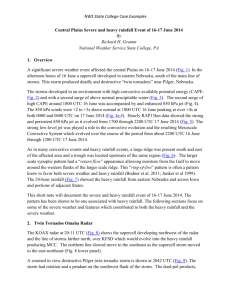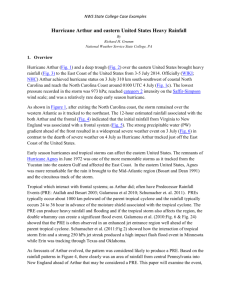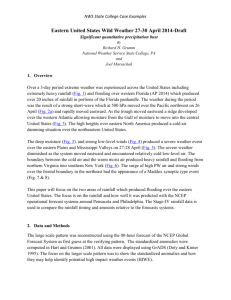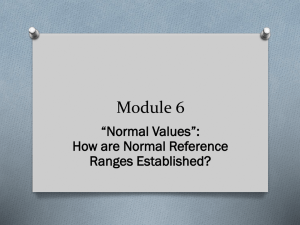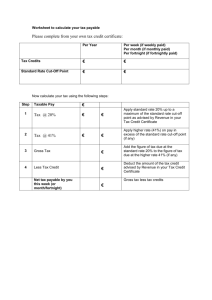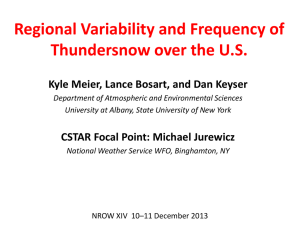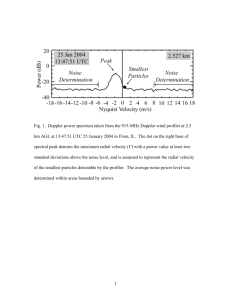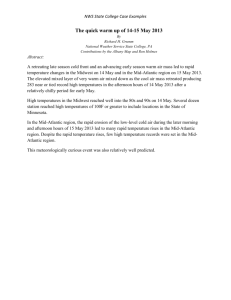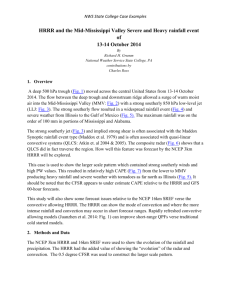09May2013
advertisement
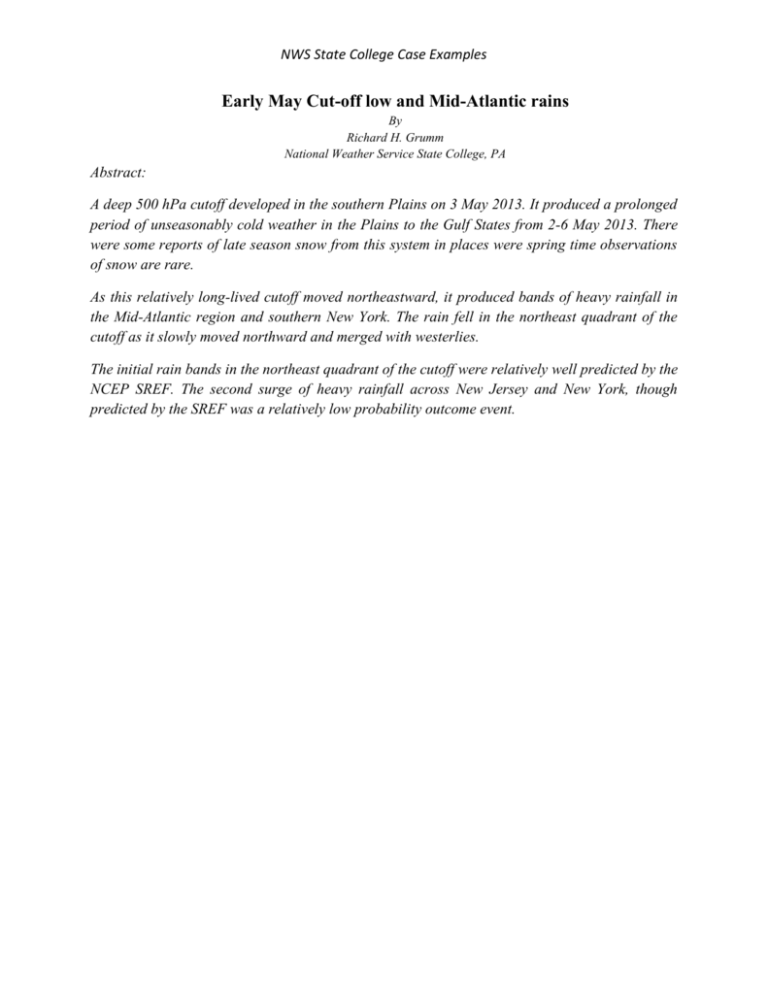
NWS State College Case Examples Early May Cut-off low and Mid-Atlantic rains By Richard H. Grumm National Weather Service State College, PA Abstract: A deep 500 hPa cutoff developed in the southern Plains on 3 May 2013. It produced a prolonged period of unseasonably cold weather in the Plains to the Gulf States from 2-6 May 2013. There were some reports of late season snow from this system in places were spring time observations of snow are rare. As this relatively long-lived cutoff moved northeastward, it produced bands of heavy rainfall in the Mid-Atlantic region and southern New York. The rain fell in the northeast quadrant of the cutoff as it slowly moved northward and merged with westerlies. The initial rain bands in the northeast quadrant of the cutoff were relatively well predicted by the NCEP SREF. The second surge of heavy rainfall across New Jersey and New York, though predicted by the SREF was a relatively low probability outcome event. NWS State College Case Examples 1. Overview A deep 500 hPa cut-off low meandered across the southern United States and into the northeast from 2-9 May 2013 (Fig. 1). Beneath this deep low 850 hPa temperatures were -3 to -4 below normal (Fig. 2). This air mass brought a late season cold snap to the plains and reports of snow well south for the month of May. The deep low (Fig. 1) moved beneath a blocking mid-latitude ridge which was focused over northeastern Canada (Fig. 1a-c). As the ridge weakened with time the close low moved northeastward into the Mid-Atlantic region and northeastern United States before getting absorbed into the westerlies around 1200 UTC 10 May 2013 (Fig. 1i). Bell and Bosart (1993) noted the amplification of a ridge over the western United States and adjacent eastern Pacific during the evolution of a cut-off over the eastern United States. Note the strong ridge in Figure 1a-c during the evolution of the cut-off of May 2013. The cut-off Early and late season cut-off lows. The implied impulse in the northwest flow east of the ridge axis was the feature which would deepen and become the deep cut-off over the southern Plains. Visually, the process was similar to that outlined by Bell and Bosart (1993). The evolution shown in Figure 1 is similar to the cut-off evolution shown by Nieto et al. (2005:Fig. 1) to include the re-absorption into the westerlies during the final stage. The cut-off of 2-10 May 2013 was nearly poster child for their described evolution of cut-offs. From a climatological perspective, cut-off development in the United States and North America peaks in the months of July to September, with strong secondary maximum in April-May-June and weaker signal in the autumn months of October-November-December (Nieto 2005:Fig 10). The primary location of cut-off evolution over North America is off the coast of California though a secondary maximum extends from the southern plain into eastern Canada (Nieto et al 2005:Fig. 8). Cutoffs can impact the total precipitation and have been shown to produce heavy rainfall events. Payer (2010) identified patterns of heavy precipitation (HP) and low precipitation (LP) cutoff in the northeastern United States. Strong southerly flow with deep moisture and easterly flow tend events tend to produce heavy precipitation events. Events with more northwesterly flow tend to produce few significant precipitation events. Heavy rainfall in northwesterly flow behind a cutoff is not a good location for heavy rainfall. This paper will examine impacts of the enduring cutoff low of 3-9 May 2013. The key aspects here are focused on the weather in the Mid-Atlantic region to include several days of locally moderate to heavy rainfall. The persistent cutoff low and much of the associated cold and snow in the plains and southern United States will likely be studied in more detail by others. NWS State College Case Examples 2. Data and Methods The large scale pattern was reconstructed using the Climate Forecast System (CFS:Saha 2010) 6hourly data and CFS based 30-year climatic means and standard deviations. The standardized anomalies were computed in Hart and Grumm (2001). All data were displayed using GrADS (Doty and Kinter 1995). The Stage-IV rainfall data were used to get event total, 6,12,24 and longer rainfall estimates. 3. Pattern overview The 500 hPa pattern from 1200 UTC 2 to 10 May 2013 (Fig. 1) showed a weakening cutoff low over the Gulf States at 1200 UTC 2 May 2013 and a strong 500 hPa ridge off the West Coast. East of this strong ridge a small wavelength trough was dropping into the plains (Fig. 1a). This system cut-off over the southern Plains at 1200 UTC 3 May and the previous cutoff became less descript over Florida (Fig. 1b). The second stronger cutoff had -3 to -4s height anomalies near the low center as it drifted across the southern plains on 4-5 May (Fig. 1c-d) and began to fill in as it reached the southeastern United States. The system turned northward up the East Coast and began to get absorbed into the westerlies on 9-10 May. This cut-off clearly persisted from 3-9 May and became an open wave on 10 May 2013. The deep cutoff low was associated with a pool of cold air at 850 hPa (Fig. 2). This cold air brought -3 to -4s 850 hPa temperatures into the Deep South. NCDC daily low maximum temperature data suggest 40 to 53 daily low maximum temperature records were set or tied from 2-5 May in the central and southern United States. Similarly, 32 to 66 daily record low temperature records were set or tied from 2-6 May 2013. These data suggest that the cutoff brought unseasonably cool weather to much of the central and southern United States during the first week of May 2013. The composite pattern and anomalies over the central United States (Fig. 3) shows that in the mean the 500 hPa cutoff and cold 850 hPa temperatures persisted for most of the period covered by the NCDC period of cooler than normal temperatures. As the 500 hPa cutoff moved into the Mid-Atlantic region it produced several bands of rain to the north and east of the 500 hPa low center (Figs. 4-5). The stronger bands of rain on 7 and 8 (Figs. 4c-d and 5a-b) May were associated with deep south-southeasterly flow on the north east side of the cutoff. As the flow became more westerly and northwesterly on 9 May (Figs. 5c-d) the rainfall amounts were considerably lower. The more notable periods of rain were observed in the mountains of North Carolina (Fig. 4b-c) and Virginia (Fig. 4c & 5a) and southeastern New York (Fig. 5b). NWS State College Case Examples The heavy rainfall over the 48 hour period from 1200 UTC 7-9 May (Fig. 6) showed that there were several distinct and persistent rainbands that brought locally heavy rainfall to the MidAtlantic region. For the most part the bands were oriented from southeast to northwest over North Carolina, Virginia, Pennsylvania, New Jersey and New York. 4. Forecast The large scale pattern was generally well predicted with 4-7 days of lead-time and is not shown here. The focus here is on the NCEP SREF forecasts for initial bands of rainfall on 7-8 May 2013 on the northeast side of the 500 hPa cut-off low. The 6 SREFs predicted a band of moderate to heavy rainfall to impact the mountains of Virginia between 1200 UTC 7-8 May 2013 (Fig 6). Forecasts for the second period of heavy rainfall from 0000 UTC 8-9 May (Fig. 7) showed the correct general region though rainfall over 25 mm was forecast as a 40% outcome. The region to be affected and the pattern of the rainfall was well forecast but the SREF underestimated the rainfall. 5. Summary A From a climatological perspective, cut-off development in the United States and North America peaks in the months of July to September, with strong secondary maximum in AprilMay-June and weaker signal in the autumn months of October-November-December (Nieto 2005:Fig 10). The two cut-off of April and May 2013 occurred during the secondary maximum time of year. Lasting 5-6 days the cut-off of 2-8 May 2013 was a relatively long-lived cut-off. Most cut-offs only lasted about 2 days (Nieto et al 2005). Previous research suggested subtropical cut-off were shorter-lived than polar cut-offs. The intrusion of cold air may be a key factor in some of the longer-lived polar cut-offs. The 7-day event of May 2013 showed the importance of cold air in maintaining this long-lived cut-off. Figures 4,5, and 6 all suggest that the favorable location of heavy rainfall is in the northeastern quadrant of a slow moving 500 hPa low. During this warm season example, the heavy rain fell in bands oriented from south-southeast to north-northwest. There was clearly no heavy rainfall in the westerly flow and northwesterly flow quadrants of the 500 hPa cutoff low. 6. Acknowledgements 7. References Bell, Gerald D., Lance F. Bosart, 1993: A Case Study Diagnosis of the Formation of an Upper-Level Cutoff Cyclonic Circulation over the Eastern United States. Mon. Wea. Rev., 121, 1635–1655. NWS State College Case Examples Doty, B.E. and J.L. Kinter III, 1995: Geophysical Data Analysis and Visualization using GrADS. Visualization Techniques in Space and Atmospheric Sciences, eds. E.P. Szuszczewicz and J.H. Bredekamp, NASA, Washington, D.C., 209-219. Grumm, R.H. and R. Hart. 2001: Standardized Anomalies Applied to Significant Cold Season Weather Events: Preliminary Findings. Wea. and Fore., 16,736–754. Hart, R. E., and R. H. Grumm, 2001: Using normalized climatological anomalies to rank synoptic scale events objectively. Mon. Wea. Rev., 129, 2426–2442. Nieto, Raquel, and Coauthors, 2005: Climatological Features of Cutoff Low Systems in the Northern Hemisphere. J. Climate, 18, 3085–3103. doi: http://dx.doi.org/10.1175/JCLI3386.1 Saha, Suranjana, et. al., 2010: The NCEP Climate Forecast System Reanalysis. Bull. Amer. Meteor. Soc., In Press (DOI: 10.1175/2010BAMS3001.1). NWS State College Case Examples Figure 1. CFS 500 hPa heights (m) and height anomalies (standard deviations) in 24 hour periods from a-i) 1200 UTC 2-10 May 2013. Contours every 60 m and standardized anomalies as in color bar. Return to text. NWS State College Case Examples Figure 2. As in Figure 1 except for 850 hPa temperatures (C ) and temperature anomalies. Return to text. NWS State College Case Examples Figure 3. CFS based composite pattern focused over the central United States from 1200 UTC 2 May through 0000 UTC 6 May 2013. Return to text. NWS State College Case Examples Figure 4. Stage-IV 12 hour accumulated precipitation (mm) valid for the periods ending at a) 0000 UTC 6 May, b) 1200 UTC 6 May, c) 0000 UTC 7 May, d) 1200 UTC 8 May 2013. Values in mm as in color bar. Return to text. NWS State College Case Examples Figure 5. As in Figure 4 except for 8 and 9 May 2013. Return to text. NWS State College Case Examples Figure 6. As in Figure 4 except for total estimated precipitation from 1200 UTC 7 May though 1200 UTC 9 May 2013. Return to text. NWS State College Case Examples Figure 7. NCEP SREF forecasts showing the probability of 25mm or more QPF for the 24 hour period ending at 1200 UTC 8 May 2013 from NCEP SREFS initialized at a) 0900 UTC 5 May 2013, b) 1200 UTC 5 May 2013, c) 0900 UTC 6 May, d) 2100 UTC 6 May, e) 0300 UTC 7 May and f) 0900 UTC 7 May 2013. Return to text. NWS State College Case Examples Figure 8. As in Figure 7 except for the 24 hours ending 0000 UTC 9 May 2013 and forecasts from a) 0900 UTC 6 May, b) 2100 UTC 06 May, c) 0300 UTC 7 May, d) 0900 UTC 7 May, e) 1500 UTC 7 May, and 2100 UTC 07 May 2013. Return to text. NWS State College Case Examples NWS State College Case Examples NWS State College Case Examples NWS State College Case Examples

